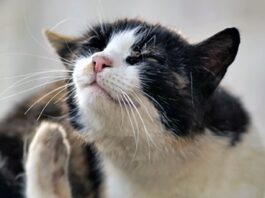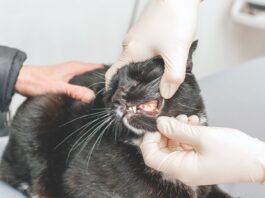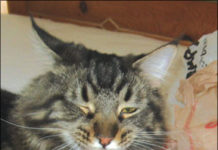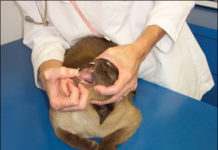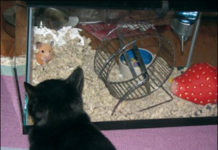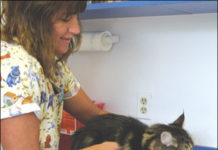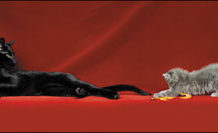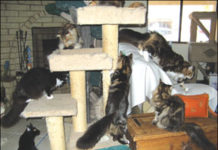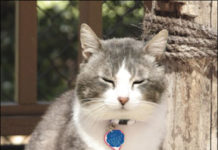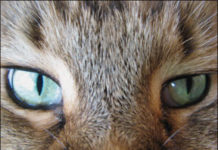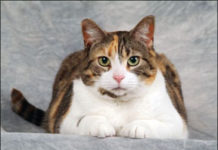Ask Elizabeth: 04/08
Dear Elizabeth, I have four cats in my household and one of them, Tabitha, has a tendency to chew and eat plastic. Ive caught her chewing on plastic bags that Ive carried in from the store, as well as items in the basement that are wrapped in plastic. I worry that she could choke to death or hurt herself somehow. Why does she do this? One of my other cats is aggressive and chases her. Tabitha is afraid and will not fight back; could her plastic obsession be stress-related? Any ideas of what I can do?
Ask Elizabeth: 03/08
Dear Elizabeth, I am an elderly cat owner. Im old and so is my girl, Pearl. Over the years, we have gotten used to many changes in visits to our veterinarian. For example, Pearls "yearly shot" is no longer annual, and screening lab work is an expected part of her exam. These changes have been explained to me and I accept them, but there is one thing I just cant get used to. Years ago our vet would take a few minutes on the exam table to clean Pearls teeth. Pearl didnt like it much, but the vet was able to take care of her teeth without anesthesia right in the office. Now, that office procedure just isnt offered; instead our vet is recommending anesthesia for dental cleaning. Pearl has visible tartar on her teeth, but why cant my vet just clean them in the exam room?
Ask Elizabeth: 02/08
Dear Elizabeth: My teenager is crazy about animals - she wants to be a veterinarian and is constantly asking to bring home all sorts of pets. We have dogs, horses, goats, an alpaca and, of course, a cat (Buster). For my daughters birthday, she is begging me to let her adopt a Guinea pig from our local shelter. So far, I have managed to hold firm to my rule of no caged pets, but Im…
Ask Elizabeth: 01/08
Dear Elizabeth: My feline housemates and I think your column is always interesting and informative. But we are beginning to wish our person would stop reading it to us, because now she wants to know why we cant write a column and be famous like you. I spend a lot of time on the computer - I mean, I even sleep on that keyboard! - but nothing good ever comes of it. And besides, Ive always thought that it was quite enough to be beautiful, well groomed and purrfectly delightful. How can I get my person to stop finding fault where there obviously is none?
Ask Elizabeth: 12/07
Dear Elizabeth, I read the column about your weight problem a few months ago; how is your diet going? Ive tried to follow your advice when feeding my own chubby cat, Ernie, but am having a tough time. I calculated his daily calorie requirement as you suggested and split that amount between breakfast and dinner. But since I work all day I leave him a little extra dry food in a bowl for lunch. Its always gone when I get home so he must get really hungry during the day. Then, after he gobbles up his dinner hes okay until much later when he really needs a small bedtime snack. I know that his total calorie intake each day is more than the formula says he needs, but hes so hungry! How have you managed your appetite?
Ask Elizabeth: 11/07
Dear Elizabeth, I cant help feeling envious of the absolutely beautiful photos that have been taken of you. You are clearly a stunning cat of exquisite beauty, but I wonder how the photographers at the Feline Health Center have been able to capture your soul in their photos. I would dearly love to have some similar photos of my equally beautiful cats, but all I get are fuzzy, out-of-focus shots of their tails as they flee the room, or photos where their eyes are red and they look devilish. Do you have any tips that you could share?
Ask Elizabeth: 10/07
It all started innocently enough, when he started feeding the strays in the neighborhood and took in a pregnant cat, which soon gave birth to six kittens. Then the neighbors started coming to him with stray kittens they found. He meant to find them all homes of their own, but good homes were hard to find. Now, he has so many cats that he cant afford to have them neutered (which means the population has been growing astronomically). Theyre not receiving any medical care, so some of them are sick, and its all he can do just to feed them each day. The neighbors are trying to have him evicted and I cant say I blame them. I dont know how to help him, but I do know something needs to be done!
Ask Elizabeth: 09/07
Dear Elizabeth: My vet tells me that my indoor-only cat, Izzy, needs to be vaccinated for rabies. We live in an apartment in New York City and Izzy is never outside, so why does she need a rabies vaccine?
Ask Elizabeth: 08/07
Pearls pupil shape is unique to the family Felidae and is meant to maximize vision in low light. Did you know that cats can see at eight times dimmer illumination than humans? This gift is part of our heritage as nocturnal, carnivorous mammals. Our ancestors success in the wild depended on being able to hunt at dusk and dawn, times of day when many potential dinner species are most active. Adaptations to the eye improved our wild relatives night vision. For house-cats like me, these adaptations enable me to hunt wild bugs in the closet at night, allow me to startle people with glow-in-the-dark reflective eyes and are part of what make me uniquely feline.
Ask Dr. Richards: 07/07
You may not be aware of this, but I, too, struggle with my weight! I arrived at the Feline Health Center slightly chubby, but healthy. Unfortunately, like many indoor cats, my energy expenditure each day was more than matched by my caloric intake. As is true for you humans, my furry body is just like a machine: If fuel input in a day exceeds energy output, the remainder is stored - as fat, which is unsightly around my middle - and unhealthy, too. My obese friends have a higher incidence of diseases such as diabetes mellitus and suffer more from conditions like arthritis.
Ask Dr. Richards: 06/07
We are enormously saddened to report an immeasurable loss to the feline community. James R. Richards, DVM, the author of this column, editor-in-chief of...
Ask Dr. Richards: 05/07
But the bacterium, Yersinia pestis, widely held to be the cause of the Black Death of antiquity is alive and well, causing roughly 1,000 to 2,000 human cases of plague every year, primarily in rural areas of developing countries. Requisites for the diseases persistence are the availability of rodent (or sometimes rabbit) "reservoirs" with the ability to reproduce to high numbers, the year-round feeding of appropriate flea "vectors" and the proper environmental conditions. In the United States, the majority of cases in reservoir rodents - usually rock squirrels, ground squirrels and prairie dogs - occurs in the Southwest, but infected animals may be seen anywhere west of the Rockies. During heavy outbreaks in these animals, cases have been detected as far east as Oklahoma, Kansas and Texas. Most human cases of plague in the U.S. arise from two areas: one in the region encompassing southern Colorado and northern New Mexico and Arizona, and the other encompassing western Nevada, California and southern Oregon.



